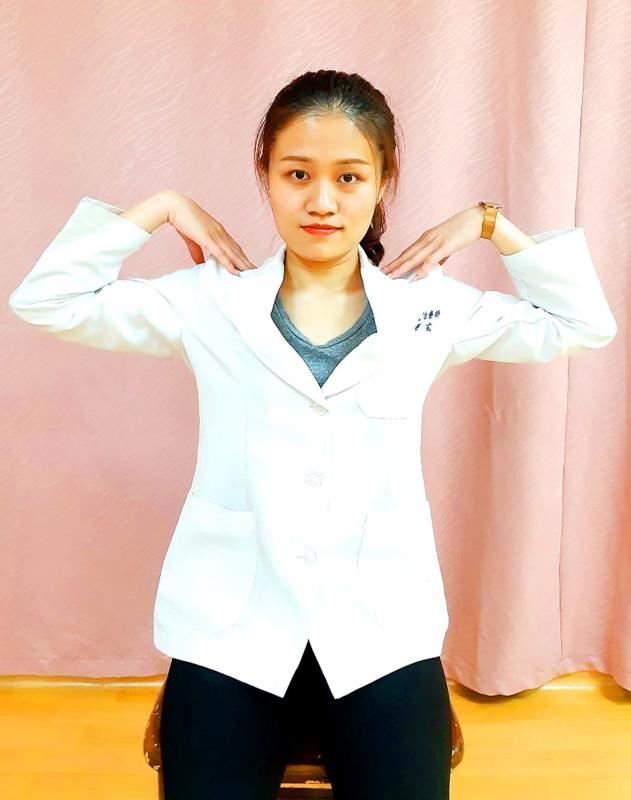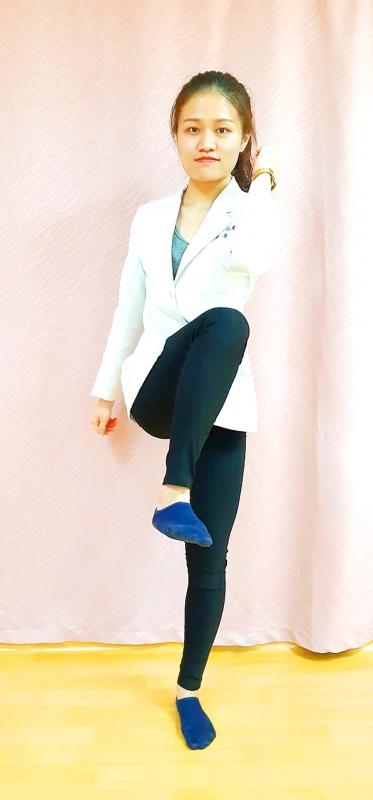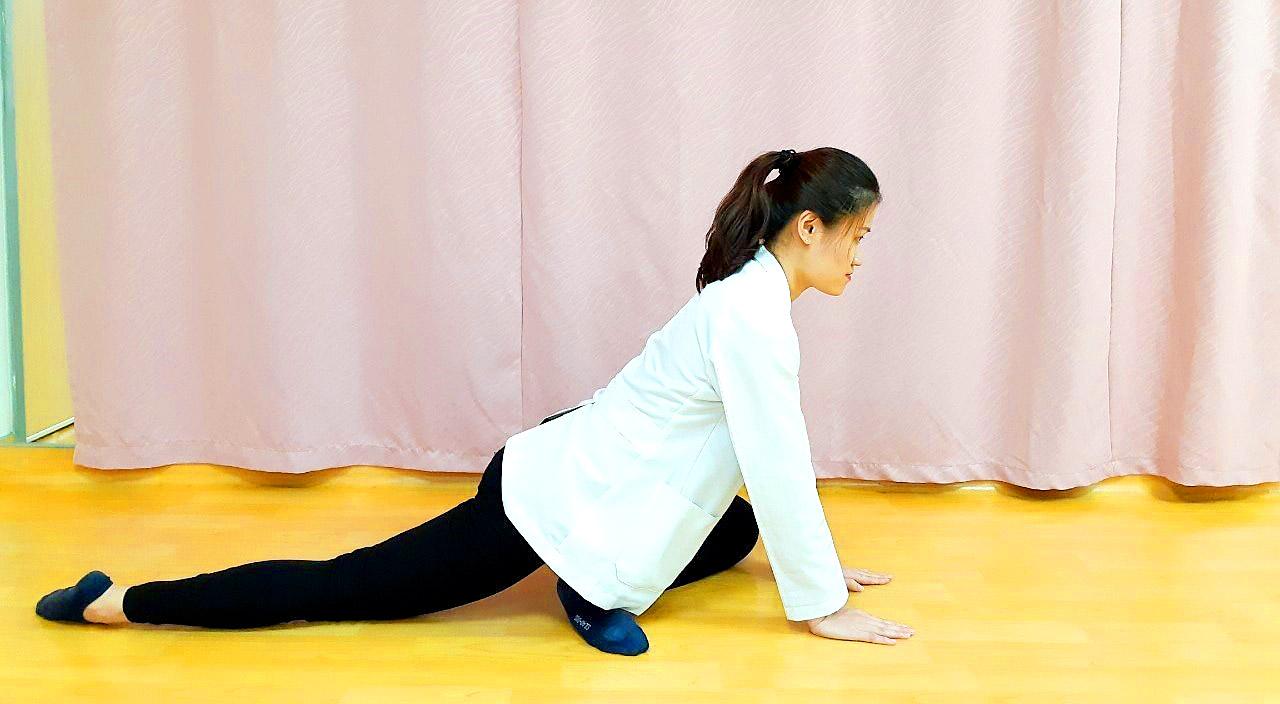In order to tackle the worsening COVID-19 crisis, it is important to wash your hands carefully and wear a mask. It is also important to improve your physical immunity and resistance. According to Tsai Chien-tsung, the head of the rehabilitation department at the Miaoli Municipal Da Chien General Hospital, the main ways to increase one’s immunity are having sufficient sleep, a balanced diet and the proper amount of exercise and relaxation. You can try some medium-level exercises to improve your immunity and resistance, together with some gentle abdominal breathing exercises and post-workout stretching exercises to alleviate stress and improve your sleep.
Tsai has shared with us five exercises you can do at home to help fend off the virus, covering the four main aspects of relieving pressure on the backbone, muscle stretches, cardiopulmonary strengthening and helping you keep calm.
The first exercise is pulling back your chin: sit up straight and breathe out while lightly pressing on your chin with your index finger, look straight ahead and do not look down or up. When you can feel some strain on the back of your neck, gradually return to the original position. Repeating this movement between 15 and 20 times can help your head find its optimal position, and relieves stress on the neck vertebrae.

Photo: Chang Hsun-teng, Liberty Times
照片:自由時報記者張勳騰
The second exercise is shoulder rotations. Sit up straight and place both hands lightly on the same shoulder, with the elbows facing forward. Next, gently describe a circle, starting from the shoulder, first forward and then back, in such a way as you do not feel discomfort, gradually increasing the size of the circles. Repeat this exercise 20 to 30 times. This exercise can prevent muscle strain in the neck and upper shoulder and release stress around the shoulder blade and the joints of the thoracic vertebrae.
Third are some abdominal breathing exercises. Loosen your belt, place your two hands gently on your abdomen and breathe in through your nose and out through your mouth. Start by exhaling slowly until your lungs are empty, feeling with your hands the abdomen sinking down. Next, inhale evenly and slowly though your nose until you can inhale no more, this time feeling with your hands your abdomen expanding. Through this whole process you should keep relaxed, and you should continue for between five and 10 minutes. This exercise should increase your aerobic capacity, promote blood circulation and alleviate stress.
The fourth exercise is touching elbows and knees. Stand straight, the elbows relaxed and slightly bent. Bring one knee up to above the waist and bring it into contact with the elbow on the other side, with the supporting leg providing stability. Then go back into the upright position and repeat, swapping sides. The movements should be as rapid as you can make them, to increase the aerobic benefit, but at the same time you should ensure that you remain balanced. Move for 30 seconds, rest for 30 seconds, and repeat the process for eight to 12 times, continuing for about 10 minutes. This exercise can promote cardio-pulmonary function, strengthen the muscles in the waist and buttocks and relieve stress in the lumbar vertebra (lower backbone).

Photo: Chang Hsun-teng, Liberty Times
照片:自由時報記者張勳騰
The fifth exercise is waist and buttock stretches. Sit on the ground, your two hands on the floor, your head facing forward. Next, bend your leg and bring it forward, with the other leg stretched out behind you and your body center of gravity around the middle of your torso. Gradually stretch your arms out in front of you, with even movement, making sure that your keep your chest upright and your belly facing down, until you can feel your muscles are stretched tight. Remain in this position for between 30 to 35 seconds and then do it over, but this time swapping legs. This exercise can be repeated three or four times.
Tsai reminds people that they should drink lots of liquids after exercise, and to remember to do between five to 10 minutes of warming up or stretching exercises to make sure you don’t strain your muscles.
(Translated by Paul Cooper, Taipei Times)

Photo: Chang Hsun-teng, Liberty Times
照片:自由時報記者張勳騰
面對武漢肺炎疫情升溫,除勤洗手及戴口罩,增加自身免疫力及抵抗力也是不可或缺的。苗栗市私立大千綜合醫院復健科主任蔡建宗建議,增加免疫力的方法主要是充足睡眠、均衡飲食、適當運動及紓壓。其中可選擇中等強度的運動來增加免疫力及抵抗力,而和緩的腹式呼吸及運動後的伸展則可抒發壓力、增進睡眠。
蔡建宗分享五招居家防疫運動,涵蓋脊椎減壓、肌肉延展、心肺強化、穩定情緒四大面向。
一、下巴後縮運動:身體坐直,邊吐氣邊用食指輕壓下巴,視線保持水平,勿低頭或仰頭,感受頸部後側有擠壓感後,即可慢慢回復原位,同樣動作重複執行十五——二十次,可讓頭部保持最佳位置,釋放頸椎壓力。

Photo: Chang Hsun-teng, Liberty Times
照片:自由時報記者張勳騰
二、肩胛繞圈運動:身體坐直,將雙手手部輕放於同側肩膀,手肘朝向前方,接著以肩膀為軸心,緩慢的由前側往後側畫圈,以不產生疼痛為原則,漸進式加大繞圈範圍,同樣動作重複執行二十——三十次。此動作可避免上肩頸緊繃,釋放肩胛與胸椎關節壓力。
三、腹式呼吸運動:身體坐直,衣褲調鬆,雙手輕放於腹部,採用「鼻吸嘴吐」的方式,先將空氣用嘴巴緩緩吐盡,同時雙手會感受到腹部持續內縮,接著用鼻子均勻且緩慢的吸氣吸到滿,此時雙手可感覺到腹部持續鼓起,整個過程保持輕鬆並持續五——十分鐘,可幫助提高身體含氧量、促進血液循環、舒緩壓力。
四、肘膝互碰運動:身體站直,雙肘輕鬆彎曲,一側膝蓋往上抬過腰,碰觸對側的手肘,另一側支撐腳保持身體穩定,然後回復站姿並換另一邊動作。動作盡量迅速來提升有氧強度,但整體仍須保持穩定平衡,每次運動三十秒、休息三十秒,反覆執行八——十二次,持續十分鐘。此運動可促進心肺功能、強化腰臀肌力、釋放腰椎壓力。

Photo: Chang Hsun-teng, Liberty Times
照片:自由時報記者張勳騰
五、腰臀伸展運動:側坐於地板,雙手放置地面,臉朝前方,接著前腿髖膝彎曲,後腿髖膝打直,身體重心落在軀幹正中間,雙手保持平行緩慢前伸,過程中軀幹保持挺胸,肚臍保持朝正下方,感受肌肉伸展的緊繃感,維持三十三十五秒後換邊執行,可反覆執行三、四次。
蔡建宗提醒民眾,運動後要適當補充水分,並記得有五——十分鐘的緩和或伸展運動,才不會造成身體負擔。
(自由時報)

The Dutch introduced the Indian mango (Mangifera indica) to Taiwan in the 17th century. It is a green-skinned mango with thick fibers that get stuck in the teeth, but it boasts a rich aroma and a unique taste. In 1954, Taiwan’s Council of Agriculture introduced several mango cultivars from Florida, USA, including the Irwin, Haden, and Keitt varieties. After seven years of testing and domestication, the Irwin variety was chosen for promotion. Years later, the sample saplings started to bear fruit. These mangoes were large, with thin, vibrant red peels and golden pulp. The Irwin mangoes were mouth-wateringly sweet and

As the priest Antonius Hambroek stood in the dim chamber of Fort Zeelandia, his eldest daughter clung to him, her voice trembling. “Father, don’t go. They’ll kill you, and what will become of Mother and my sisters?” Outside, the sounds of Koxinga’s relentless canon siege boomed through the fortress. The defenders were on the brink of collapse. Starvation gnawed at their resolve, and the air carried the acrid stench of spent gunpowder and rotting flesh. Dutch reinforcements from Batavia had failed to arrive, leaving the garrison isolated and hopeless. Hambroek’s face was calm, though sorrow weighed heavily on his

對話 Dialogue 清清:今天中午我要多吃一點,不然晚上可能會吃不飽。 Qīngqing: Jīntiān zhōngwǔ wǒ yào duō chī yìdiǎn, bùrán wǎnshàng kěnéng huì chībùbǎo. 華華:怎麼了?為什麼會吃不飽? Huáhua: Zěnmele? Wèishénme huì chībùbǎo? 清清:今天大年初七,是「人日節」,傳統上結了婚的女兒要回家給父母送長壽麵,而且最好是素的,我姐姐會回來,只吃素麵,我應該很快就餓了。 Qīngqing: Jīntiān Dànián chūqī, shì “Rénrì jié,” chuántǒng shàng jiéle hūn de nǚ’ér yào huíjiā gěi fùmǔ sòng chángshòumiàn, érqiě zuìhǎo shì sù de, wǒ jiějie huì huílái, zhǐ chī sùmiàn, wǒ yīnggāi hěn kuài jiù èle. 華華:我還是第一次聽說有「人日節」呢!這是怎麼來的啊? Huáhua: Wǒ háishì dì yī cì tīngshuō yǒu “Rénrì jié” ne! Zhè shì zěnme lái de a? 清清:老一輩的人說,女媧是在第七天造出了「人」,所以今天可說是我們每個人的「生日」呢!生日快樂! Qīngqing: Lǎoyíbèi de rén shuō, Nǚwā shì zài dì qī tiān zào chūle “rén,” suǒyǐ jīntiān kěshuōshì wǒmen měi ge rén de “shēngrì” ne! Shēngrì kuàilè! 華華:你也是啊!欸?那前六天女媧都做了什麼呢? Huáhua: Nǐ yěshì a! Éi? Nà

As we bundle up in thick coats to stay warm during the winter, there is a population that has already adapted to extremely low temperatures. These people live in the remote city of Yakutsk, the coldest city on Earth. Yakutsk is situated in the heart of Siberia, which is the capital of the Sakha Republic in Russia. This historic mining city began to flourish in the 19th century following the discovery of gold deposits. Given its construction on permafrost, the average temperature in the city remains below 0°C for over half the year, with winter temperatures dropping to an astonishing -50°C.